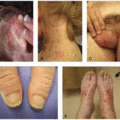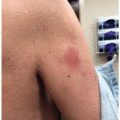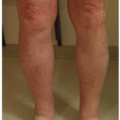Purpuric Reactions
Jasmine Rana
Bernice Y. Kwong
Purpura is due to red blood cells extravasating into the skin or mucous membranes. Purpuric lesions present as deep red to purple in color and do not blanch. Purpuric eruptions may present as pinpoint petechiae, macular purpura, palpable purpuric papules or nodules or as retiform purpura, which may be inflammatory or noninflammatory. These eruptions in the cancer patient can have many causes, including neoplastic, infectious, vascular, and drug-induced etiologies. While the focus here is on drug-induced purpura as sequelae of oncologic therapy, the differential for purpuric and petechial eruptions in immune-compromised patients receiving anticancer therapy is broad; hence, there should be a low threshold for dermatology consultation and skin biopsy (including tissue cultures) in the setting of purpuric dermatoses in the oncologic patient. Furthermore, any drug reaction pattern (eg, morbilliform, lichenoid, toxic erythema of chemotherapy,1 etc.) can appear purpuric if there is an underlying bleeding diathesis (eg, iatrogenic, nutritional, thrombocytopenia, etc.) (Figure 10.1).
Purpuric drug eruptions have been implicated with epidermal growth factor receptor (EGFR) inhibitors, occurring a median of 3.5 months after initiation of treatment, often on the lower legs with a nonfollicular distribution (Figure 10.2). Leukocytoclastic vasculitis is rarely seen on histopathology, but secondary infection with angioinvasive pathogens (eg, staph aureus, pseudomonas, candida) is common and systemic antimicrobial directed treatment is effective. Purpuric eczema craquele-like eruptions, often on the lower legs, have also been described as a reaction pattern associated with EGFR inhibitors.2
Bruton tyrosine kinase (BTK) inhibitors may contribute to collagen-mediated platelet activation and are commonly associated with purpuric eruptions. Reactions include a late onset (median 3 months) nonpalpable asymptomatic petechial rash that often does not require treatment and an early onset (median 15 days) palpable pruritic rash (can correspond to transient lymphocytosis during treatment) that can be treated with topical or systemic steroids, oral antihistamines, and/or temporary treatment interruption.3 BTK inhibitors may induce a variety of other morphologic presentations, mimicking EGFR inhibitors, and due to impact on platelets, virtually all presentations can appear purpuric4 (Figure 10.3).
Stay updated, free articles. Join our Telegram channel

Full access? Get Clinical Tree







